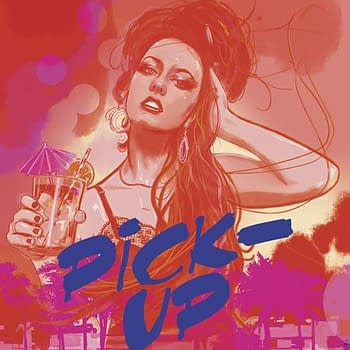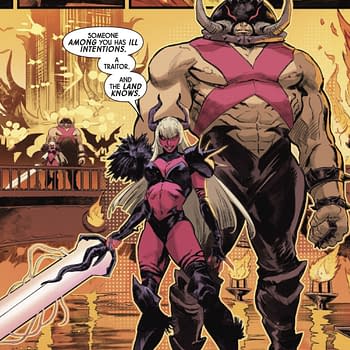Posted in: Comics, Recent Updates | Tagged: batgirl, Comics, dc, gail simone, oracle
The Million-Dollar Debut Of Barbara Gordon by Eric Glover

With Batgirl #1 now on shelves and DC's decision to undo Barbara Gordon's paralysis finally executed, the curtain has been pulled back on enough aspects of the Oracle debate to make more educated assumptions about the company's direction with the character and her place in the larger context of DC's disability visibility. The debut issue, along with tidbits of information Batgirl writer Gail Simone has provided in interviews, aren't sufficient to comprehensively assess how DC will fill the void of diversity left behind by Oracle, but they do provide enough clues to get an idea—and the verdict, as expected, is complicated.
What's most notable about Batgirl #1 is its direct acknowledgement of Batman: The Killing Joke, the controversial '80s comic that paralyzed Barbara Gordon in the first place. In Batgirl #1, Barbara explains through narration that the events of that story—in which the Joker shot her through the spine—now happened three years ago. And though the injury paralyzed her for a time, Barbara is presently fighting on her feet again. Batgirl #1 stays secretive about exactly what fixed Barbara's spine, which—while an excellent ploy to bring readers back—provides little comfort to fans agitated by the erasure of her disability thus far. However, a previous statement by Simone during her interview with Jill Pantozzi likely sheds light on what kind of explanation we'll get:
"I will say I've always resisted the idea of something like Zatanna or a Green Lantern suddenly snapping their fingers and poof, she's suddenly breakdancing." –Gail Simone
This statement matches DC's announcement that Barbara would be going through physical rehabilitation to regain the use of her legs. Since physical therapy would be completely unnecessary after the use of any of DC's "magical" methods of restoration—such as a Purple Ray, Lazarus Pit, or futuristic cybernetics—it's probably safe to say that Simone has a much more grounded method of healing Barbara in mind. Because the relaunch allowed for complete freedom of continuity changes, Simone likely took the liberty of keeping Barbara's injury critical enough to temporarily incapacitate her legs, but not damaging enough to prevent a realistic—albeit prolonged—recovery.
If this is the direction Simone plans to take with the character, then Barbara's healing process will be one that fully respects what some real people with disabilities go through on the road to recuperation. All in all, it seems Simone is aiming to get Barbara back on her feet in a way that doesn't tastelessly discard her disability, but rather esteems the hard work of those struggling to cope with and move on from their own whenever possible.
Story-wise, this kind of progression has potential to pack an incredibly emotional punch. Seeing as Batgirl #1 draws its strength from the motif that Barbara Gordon is a physical and emotional survivor, a comeback tale that uses real-world medical developments to sustain it could have true resonance for readers with disabilities. Granted, many readers with disabilities probably have conditions from which they can't recover at all, but this route for Barbara would have more relevance and reverence regarding the disabled community than the usual plot contrivances used to "defrost" characters from disabilities. A move like this would be the most dignified way to transition Barbara out of her disabled role, and Batgirl #1 proves that "transition" is in fact the key word, here. In one scene between Barbara and her father, Commissioner Jim Gordon, her dad expresses joy at seeing her walking again. In another scene, Barbara's new roommate utters language equating the use of a wheelchair with being "bound" or "confined" to one, which has offensive implications for some people with disabilities. Barbara winces inwardly, confirming that her identity is still somewhat tied to her days with a disability. Surely, if we're saying goodbye to Barbara's paralysis, it will be a gradual shift that acknowledges the importance of disability to the character and to fans with who may have one.
But then what?
Eventually, Barbara will move on from her disability. Sooner or later, flashbacks or exposition regarding her physical recovery won't be necessary anymore. Fans will be caught up on what happened during her days in a wheelchair, and that story—like Oracle's—will fade into the character's past. The further DC propels Barbara into her able-bodied life, the lesser the consequence of her history as a paraplegic. It's fantastic that Simone might be tearing off the band-aid slowly, but the scar remains: This is still the loss of a crucial disability icon. The farewell may be slow and the changeover smooth, but even the most skillful approach in the world (and Simone's very well may be) can never compensate for the tremendous blow to representation Barbara's healing brings about.
Simone has assured readers that she recognizes this problem in a recent interview:
"We do plan to address this, in several big ways, one of which is making sure that one character no longer represents almost the entire disabled community in the DCU anymore." –Gail Simone
This statement echoes one that she made during the Pantozzi interview in June, in which she promised that DC was working on bringing more characters with disabilities into the DC universe. Aside from writer Paul Cornell, who's talked up a horse rider unable to walk in his Demon Knights comic, Simone is the only DC creator to be notably vocal about disabilities receiving broader attention post-relaunch–which likely means she's spearheading the effort with contributions from a few others at most. No doubt the work going into these new characters will bring about some interesting new heroes, but their staying power, of course, will remain to be seen for quite some time—while Oracle already had a built-in fan base that sustained her popularity for over 20 years.
Since there's little chance this freshmen class of disabled characters will have anything more than supporting roles in books with able-bodied heroes, their arrival should be celebrated, but regarded with caution given their unguaranteed popularity. Although these characters are definitely needed, they are being used to fill a vacuum rather than to build upon any kind of foundation laid for them. It would seem that Barbara's successors were afterthoughts of a business decision that devastated DC's disability diversity, rather than earnest outgrowths of a pre-existing commitment to honoring the underrepresented.
No matter how well-written they are, there's no denying that it will be a long and uphill battle to guarantee them a "fixed" status anytime soon. And considering that curing Barbara had been unthinkable for two decades, her change has revealed DC's true colors on the matter: Disabled heroes, regardless of how dearly they're loved, will quite possibly never enjoy a safe position in the DCU. They may always be in danger of being forced into "normalcy," despite the promises made or the strength of the characters noted.
And at this point, DC has a lot of work ahead of them to prove otherwise.











